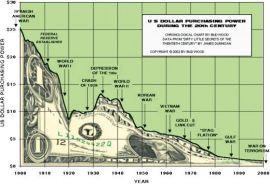Clean Energy Boom Heading to the Abyss
July 11, 2011
By. Devon Swezey
Breakthrough Institute
July 11, 2011
The global clean energy industry is set for a major crash. The reason is simple. Clean energy is still much more expensive and less reliable than coal or gas, and in an era of heightened budget austerity the subsidies required to make clean energy artificially cheaper are becoming unsustainable.
Clean tech crashes are nothing new. The U.S. wind energy industry has collapsed three times before, first in the mid 1990s and most recently in 2002 and 2004 when Congress failed to extend the tax credit that made it profitable. But the impact and magnitude of the coming clean tech crash will far outstrip those of past years.
As part of its effort to combat the economic recession, the federal government pumped nearly $80 billion in direct investment and tax credits into the clean energy sector, catalyzing an unprecedented industry expansion. Solar energy, for example, grew 67% in the United States in 2010. The U.S. wind energy industry also experienced unprecedented growth as a result of the generous Section 1603 clean energy stimulus program. The industry grew by 40% and added 10 GW of new turbines in 2009. Yet many of the federal subsidies that have driven such rapid growth are set to expire in the next few years, and clean energy remains unable to compete without them.
The crash won’t be limited to the United States. In many European countries, clean energy subsidies have become budget casualties as governments attempt to curb mounting deficits. Spain, Germany, France, Italy and the Czech Republic have all announced cuts to clean energy subsidies.
Such cuts are not universal, however. China, flush with cash, is bucking the trend, committing $760 billion over 10 years for clean energy projects. China is continuing to invest in low-carbon energy as a way of meeting its voracious energy demand, diversifying its electricity supply, and alleviating some of the negative health consequences of its reliance on fossil energy.
If U.S. and European clean energy markets collapse while investment continues to ramp up in China, the short-term consequences will likely be a migration of much of the industry to Asia. As we wrote in our 2009 report, “Rising Tigers, Sleeping Giant,” this would have significant economic consequences for the United States, as the jobs, revenues and other benefits of clean tech growth accrue overseas.
In the long-term, however, clean energy must become much cheaper and more reliable if it is to widely displace fossil fuels on the scale of national economies and become a commercially viable industry.
Breaking the Boom-Bust Cycle
Why is the United States still locked in this self-perpetuating boom-bust cycle in clean energy? The problem, according to a new essay by energy experts David Victor and Kassia Yanosek in this week’s Foreign Affairs, is that our system of clean energy subsidization is jury-rigged to support the deployment of only the least-risky and most mature clean energy technologies, while lacking clear incentives for continual innovation that could make clean energy competitive on cost with conventional energy sources. Rather, we should “invest in more innovative technologies that stand a better chance of competing with conventional energy sources over the long haul.” According to Victor and Yanosek, nearly seven-eighths of global clean energy investment goes toward deploying existing technologies that aren’t competitive without subsidy, while only a small share goes to encouraging innovation in existing technologies or developing new ones.
This must change. Rather than simply subsidize production of current technologies, we need a comprehensive energy innovation strategy to develop, manufacture, and deploy riskier but more promising clean energy technologies that may eventually compete with fossil energy at scale. Instead of rewarding companies for building the same product, we should reward companies who continuously improve designs and cut costs over time.
Such a federal strategy will require major federal investments, but of a different kind than the subsidies that have driven the clean tech industry in years past. For starters, we must dramatically ramp up funding for early-stage clean energy research and development. A growing bipartisan group of think tanks and business leaders have pushed an investment of at least $15 billion annually in energy R&D, up from its current $4 billion level.
Targeted funding is needed to solve technology challenges and ensure that innovative technologies can develop and improve. One key program that helps fulfill this need is ARPA-E, which funds a portfolio of innovative technology companies and helps connect them with private investors. But ARPA-E’s budget has continually been under assault in budget negotiations, hampering its ability to catalyze innovation in the energy sector and limiting its impact.
We also need to invest in cutting-edge advanced manufacturing capabilities and shared technology infrastructure that would help U.S. companies cut costs and improve manufacturing processes. As the President’s Council of Advisors on Science and Technology wrote in a report released last week, manufacturing is vital to innovation, “because of the synergies created by locating production processes and design processes near to each other.” Furthermore, bringing down manufacturing costs, such as by supporting shared infrastructure for small firms, or offering financing for the adoption of innovative technologies in manufacturing, will be a key component of reducing the costs of new clean energy innovations.
Lastly, the nation’s hodgepodge of energy deployment subsidies is in dire need of reform. As Breakthrough and colleagues wrote in “Post-Partisan Power,” we need an energy deployment regime that demands and rewards innovation, rather than just supporting more of the same. Brookings’ Mark Muro (a co-author or PPP) expands, “targeted and competitive deployment incentives could be created for various classes of energy technologies that would ensure that each has a chance to mature even as each is challenged to innovate and locate price declines.” Rather than create permanently subsidized industries, such investments would “provide the opportunity for opportunity for all emerging low-carbon energy technologies to demonstrate progress toward competitive costs,” while speeding commercialization.
It is clear that the current budgetary environment in the United States presents challenges to the viability of the fast-growing clean energy industry. But it also presents an opportunity. By repurposing existing clean energy policies and investing in clean energy innovation, the United States can be the first country to make clean energy cheap and reliable, a distinction that is sure to bring major economic benefits in a multi-trillion dollar energy market.


